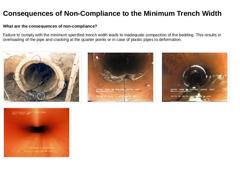
|
What are the consequences of non-compliance? Failure to comply with the minimum specified trench width leads to inadequate compaction of the bedding. This results in overloading of the pipe and cracking at the quarter points or in case of plastic pipes to deformation. (Image: Concrete pipe failure at the quarter points due to insufficient bedding compaction) (Image: Clay pipe failure due to insufficient bedding compaction) (Image: Clay pipe failure … |
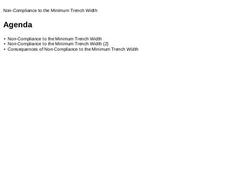
|
|
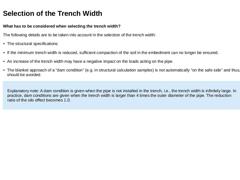
|
What has to be considered when selecting the trench width? The following details are to be taken into account in the selection of the trench width: -
The structural specifications
-
If the minimum trench width is reduced, sufficient compaction of the soil in the embedment can no longer be ensured.
-
An increase of the trench width may have a negative impact on the loads acting on the pipe.
-
The blanket approach of a “dam condition” (e.g. in structural …
|
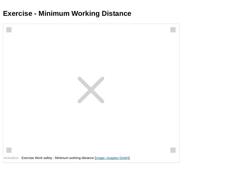
|
Animation: Exercise Work safety - Minimum working distance [Animation: visaplan GmbH]. This interactive object is only visible in the online version of the module. |
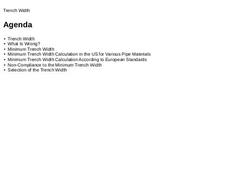
|
|
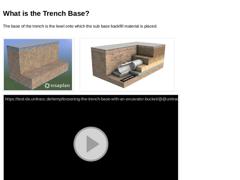
|
The base of the trench is the level onto which the sub base backfill material is placed. (Image: Trench base) (Image: Trench base) (Video: Loosening the trench base with an excavator bucket) Which excavator bucket is suitable for the trench base? Select the correct image by clicking on it. (Image: False excavator bucket) (Image: Correct excavator bucket) |
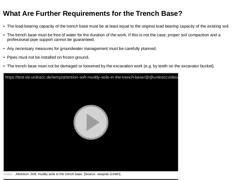
|
-
The load-bearing capacity of the trench base must be at least equal to the original load bearing capacity of the existing soil.
-
The trench base must be free of water for the duration of the work. If this is not the case, proper soil compaction and a professional pipe support cannot be guaranteed.
-
Any necessary measures for groundwater management must be carefully planned.
-
Pipes must not be installed on frozen ground.
-
The trench base must not …
|
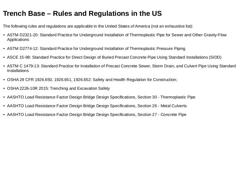
|
The following rules and regulations are applicable in the United States of America (not an exhaustive list): -
ASTM D2321-20: Standard Practice for Underground Installation of Thermoplastic Pipe for Sewer and Other Gravity-Flow Applications
-
ASTM D2774-12: Standard Practice for Underground Installation of Thermoplastic Pressure Piping
-
ASCE 15-98: Standard Practice for Direct Design of Buried Precast Concrete Pipe Using Standard Installations (SIDD)
|
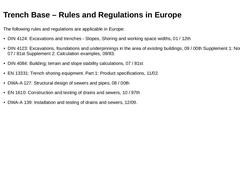
|
The following rules and regulations are applicable in Europe: -
DIN 4124: Excavations and trenches - Slopes, Shoring and working space widths, 01 / 12th
-
DIN 4123: Excavations, foundations and underpinnings in the area of existing buildings, 09 / 00th Supplement 1: Notes, 07 / 81st Supplement 2: Calculation examples, 09/83.
-
DIN 4084: Building; terrain and slope stability calculations, 07 / 81st
-
EN 13331: Trench shoring equipment. Part 1: Product …
|
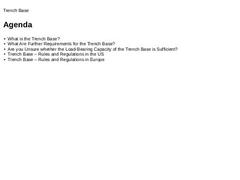
|
|
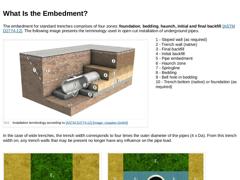
|
The embedment for standard trenches comprises of four zones: foundation, bedding, haunch, initial and final backfill [[ASTM D2774-12]]. The following image presents the terminology used in open cut installation of underground pipes. (Image: Installation terminology according to ASTM D 2774-12) 1 - Sloped wall (as required) 2 - Trench wall (native) 3 - Final backfill 4 - Initial backfill 5 - Pipe embedment 6 - Haunch zone 7 - Springline 8 - Bedding 9 - Bell … |
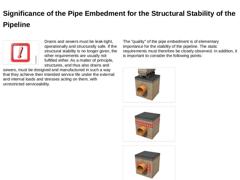
|
Important: Drains and sewers must be leak-tight, operationally and structurally safe. If the structural stability is no longer given, the other requirements are usually not fulfilled either. As a matter of principle, structures, and thus also drains and sewers, must be designed and manufactured in such a way that they achieve their intended service life under the external and internal loads and stresses acting on them, with unrestricted serviceability. |
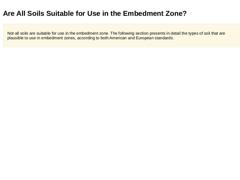
|
Not all soils are suitable for use in the embedment zone. The following section presents in detail the types of soil that are plausible to use in embedment zones, according to both American and European standards. |
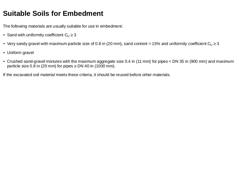
|
The following materials are usually suitable for use in embedment: -
Sand with uniformity coefficient CU ≥ 3
-
Very sandy gravel with maximum particle size of 0.8 in (20 mm), sand content > 15% and uniformity coefficient CU ≥ 3
-
Uniform gravel
-
Crushed sand-gravel mixtures with the maximum aggregate size 0.4 in (11 mm) for pipes < DN 35 in (900 mm) and maximum particle size 0.8 in (20 mm) for pipes ≥ DN 40 in (1000 mm).
If the excavated soil material … |
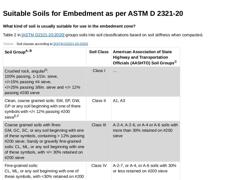
|
What kind of soil is usually suitable for use in the embedment zone? Table 2 in [ASTM D2321-20:2020] groups soils into soil classifications based on soil stiffness when compacted. (Table: Soil classes according to ASTM D2321-20) Table 3 in ASTM D2321-20 encompasses the recommendations for installatin and use of soils for foundation, embedment and backfill. (Table: Description of Embedment Material as per ASTM D2321-20) |
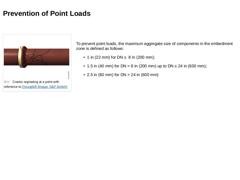
|
(Image: Cracks orginating at a point with reference to [Young84] [Image: S&P GmbH]) To prevent point loads, the maximum aggregate size of components in the embedment zone is defined as follows: -
1 in (22 mm) for DN ≤ 8 in (200 mm);
-
1.5 in (40 mm) for DN > 8 in (200 mm) up to DN ≤ 24 in (600 mm);
-
2.5 in (60 mm) for DN > 24 in (600 mm)
|
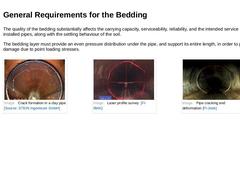
|
The quality of the bedding substantially affects the carrying capacity, serviceability, reliability, and the intended service life of the installed pipes, along with the settling behaviour of the soil. The bedding layer must provide an even pressure distribution under the pipe, and support its entire length, in order to prevent damage due to point loading stresses. (Image: Crack formation in a clay pipe) (Image: Laser profile survey) |
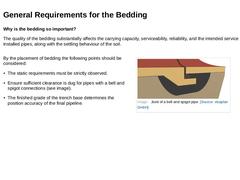
|
Why is the bedding so important? The quality of the bedding substantially affects the carrying capacity, serviceability, reliability, and the intended service life of the installed pipes, along with the settling behaviour of the soil. By the placement of bedding the following points should be considered: |
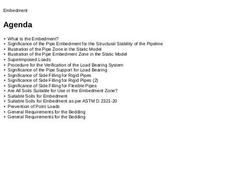
|
|
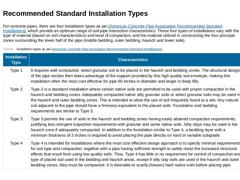
|
For concrete pipes, there are four installation types as per [[American Concrete Pipe Association Recommended Standard Installations]], which provide an optimum range of soil-pipe interaction characteristics. These four types of installations vary with the type of material (based on soil characteristics) and level of compaction, and the material utilized in constructing the four principal zones surrounding the lower half of the pipe (middle bedding, … |
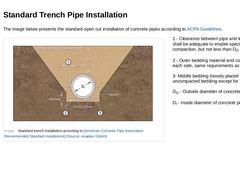
|
The image below presents the standard open cut installation of concrete pipes according to [[American Concrete Pipe Association Recommended Standard Installations]]. (Image: Standard trench installation according to ACPA) 1 - Clearance between pipe and trench wall shall be adequate to enable specific compaction, but not less than DO /6 2 - Outer bedding material and compaction each side, same requirements as haunch 3- Middle bedding loosely placed uncompacted … |
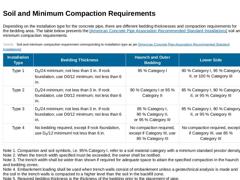
|
Depending on the installation type for the concrete pipe, there are different bedding thicknesses and compaction requirements for the bedding area. The table below presents the [[American Concrete Pipe Association Recommended Standard Installations]] soil and minimum compaction requirements. (Table: Soil and minimum compaction requirement corresponding to installation type as per ACPA Standard Installation) |
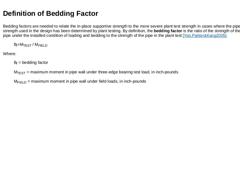
|
Bedding factors are needed to relate the in-place supportive strength to the more severe plant test strength in cases where the pipe strength used in the design has been determined by plant testing. By definition, the bedding factor is the ratio of the strength of the pipe under the installed condition of loading and bedding to the strength of the pipe in the plant test [[Yoo,Parker&Kang2005]]. Bf=MTEST / MFIELD Where: Bf = bedding factor MTEST = maximum … |
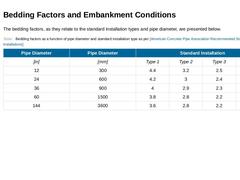
|
The bedding factors, as they relate to the standard installation types and pipe diameter, are presented below. (Table: Bedding factors, embankment conditions as per ACPA) |
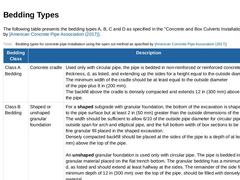
|
The following table presents the bedding types A, B, C and D as specified in the "Concrete and Box Culverts Installation" Guideline by [American Concrete Pipe Association (2017)]. (Table: Bedding types for concrete pipe installation using the open cut method as specified by ACPA) |